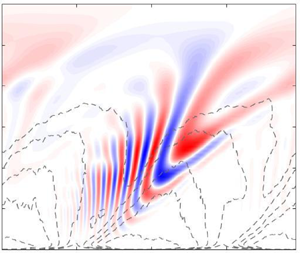Published online by Cambridge University Press: 21 November 2024

Resolvent analysis provides a framework to predict coherent spatio-temporal structures of the largest linear energy amplification, through a singular value decomposition (SVD) of the resolvent operator, obtained by linearising the Navier–Stokes equations about a known turbulent mean velocity profile. Resolvent analysis utilizes a Fourier decomposition in time, which has thus far limited its application to statistically stationary or time-periodic flows. This work develops a variant of resolvent analysis applicable to time-evolving flows, and proposes a variant that identifies spatio-temporally sparse structures, applicable to either stationary or time-varying mean velocity profiles. Spatio-temporal resolvent analysis is formulated through the incorporation of the temporal dimension to the numerical domain via a discrete time-differentiation operator. Sparsity (which manifests in localisation) is achieved through the addition of an  $l_1$-norm penalisation term to the optimisation associated with the SVD. This modified optimisation problem can be formulated as a nonlinear eigenproblem and solved via an inverse power method. We first showcase the implementation of the sparse analysis on a statistically stationary turbulent channel flow, and demonstrate that the sparse variant can identify aspects of the physics not directly evident from standard resolvent analysis. This is followed by applying the sparse space–time formulation on systems that are time varying: a time-periodic turbulent Stokes boundary layer and then a turbulent channel flow with a sudden imposition of a lateral pressure gradient, with the original streamwise pressure gradient unchanged. We present results demonstrating how the sparsity-promoting variant can either change the quantitative structure of the leading space–time modes to increase their sparsity, or identify entirely different linear amplification mechanisms compared with non-sparse resolvent analysis.
$l_1$-norm penalisation term to the optimisation associated with the SVD. This modified optimisation problem can be formulated as a nonlinear eigenproblem and solved via an inverse power method. We first showcase the implementation of the sparse analysis on a statistically stationary turbulent channel flow, and demonstrate that the sparse variant can identify aspects of the physics not directly evident from standard resolvent analysis. This is followed by applying the sparse space–time formulation on systems that are time varying: a time-periodic turbulent Stokes boundary layer and then a turbulent channel flow with a sudden imposition of a lateral pressure gradient, with the original streamwise pressure gradient unchanged. We present results demonstrating how the sparsity-promoting variant can either change the quantitative structure of the leading space–time modes to increase their sparsity, or identify entirely different linear amplification mechanisms compared with non-sparse resolvent analysis.
To send this article to your Kindle, first ensure no-reply@cambridge.org is added to your Approved Personal Document E-mail List under your Personal Document Settings on the Manage Your Content and Devices page of your Amazon account. Then enter the ‘name’ part of your Kindle email address below. Find out more about sending to your Kindle. Find out more about saving to your Kindle.
Note you can select to save to either the @free.kindle.com or @kindle.com variations. ‘@free.kindle.com’ emails are free but can only be saved to your device when it is connected to wi-fi. ‘@kindle.com’ emails can be delivered even when you are not connected to wi-fi, but note that service fees apply.
Find out more about the Kindle Personal Document Service.
To save this article to your Dropbox account, please select one or more formats and confirm that you agree to abide by our usage policies. If this is the first time you used this feature, you will be asked to authorise Cambridge Core to connect with your Dropbox account. Find out more about saving content to Dropbox.
To save this article to your Google Drive account, please select one or more formats and confirm that you agree to abide by our usage policies. If this is the first time you used this feature, you will be asked to authorise Cambridge Core to connect with your Google Drive account. Find out more about saving content to Google Drive.